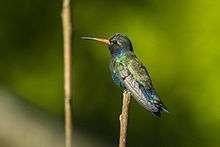Doubleday's hummingbird
Doubleday's hummingbird (Cynanthus doubledayi) is a species of hummingbird in the family Trochilidae also known as the turquoise-crowned hummingbird. Some taxonomic authorities, such as the American Ornithological Society consider this bird to be a subspecies of the broad-billed hummingbird, while others consider it distinct.
| Doubleday's hummingbird | |
|---|---|
 | |
| Scientific classification | |
| Kingdom: | Animalia |
| Phylum: | Chordata |
| Class: | Aves |
| Order: | Apodiformes |
| Family: | Trochilidae |
| Genus: | Cynanthus |
| Species: | C. doubledayi |
| Binomial name | |
| Cynanthus doubledayi Bourcier, 1847 | |
Diet
Hummingbirds in generally eat;[3]
- Nectar;
- Insects;
- Spiders
- Larvae
- Insect eggs.
- Other such small insects
Insects provide critical nutrients like fat, protein and salts that nectar does not provide.
- Sap;
Sap is consumed when nectar is unavailable and contains enough scructose to sustain the hummingbird's energy use.
- Pollen;
Although pollen is not directly consumed an amount of pollen is stuck to the Hummingbird's beak thus being ingested, only about 10% of ingested pollen is actually digested and provides a small amount of protein.
References
- Birdlife International (2014). "Cynanthus doubledayi". IUCN Red List of Threatened Species. 2014. Retrieved 12 January 2015.CS1 maint: ref=harv (link)
- "Cynanthus doubledayi range map". International Union for Conservation of Nature and Natural Resources. Retrieved 2015-01-01.
- Peaker, M. (1990-01-01). "Nutritional requirements and diets for hummingbirds and sunbirds". International Zoo Yearbook. 29 (1): 109–118. doi:10.1111/j.1748-1090.1990.tb03339.x. ISSN 1748-1090.
